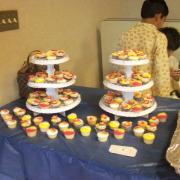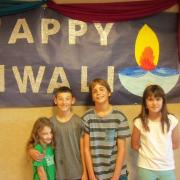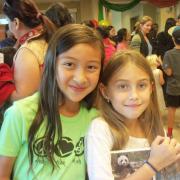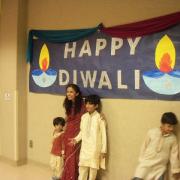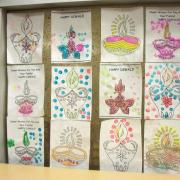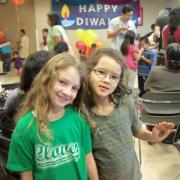The library hosted a family program celebrating Diwali, a Hindu festival of lights, held in the autumn in the Northern Hemisphere. We purchased Indian language/cultural books supporting this program with a grant from the Palms Neighborhood Council. This was one of our branch’s first programs targeting the South Asian population, and we had one of our largest crowds ever, with about 150 people attending.
The Friday program included stories, two performances set to traditional Indian music by students from Clover Elementary School (which serves a student body comprised of 42 percent Asian students), authentic Indian food, cupcakes, henna tattoos and rangoli (traditional Indian folk art). Parents and children were encouraged to come dressed in traditional Indian clothes. Diya (oil lamps with cotton wicks) were given out to the children in attendance. We also unveiled our new children's books on Indian culture and languages.
Advanced Planning
The idea to host an Indian cultural program started in spring 2015, when I attended Clover Elementary School’s International Festival and saw children performing traditional Indian dances. My goal for the library was to reach out to the large Indian community in our area and implement a program.
The program was planned about two months ahead of time, with our first planning meeting in mid-September. Initially, three mothers from the local elementary school and I planned the Diwali program. One of the parents runs the Bollywood Cultural Center of Los Angeles. Planning the program ahead of time worked in our favor because it gave me time to purchase and process new books on Indian culture/languages, acquired through a grant from the Palms Neighborhood Council.
Marketing
My goal was to reach as many families as possible. I used in-house marketing, fliers, social media, e-mail and school visits, and I also marketed directly to the school community.
About two months before the program, I promoted it on our LAPL website. I also made fliers, which were distributed and posted throughout the library. About three weeks before the program, I sent e-mails to three different groups (Indian families, after-school families and storytime families). I also sent out follow-up e-mails as the date approached.
I specifically targeted the Diwali program to the families of Clover Elementary School by promoting the program to the school's e-blast and newsletter recipients. I also did a school visit, speaking at a school assembly of about 700 people. I put fliers in the teachers’ boxes and some teachers sent home fliers.
The marketing was very successful. We were able to attract many families who already celebrate Diwali, and I was also able to reach families that were just interested in learning about the holiday.
Budgeting
Almost everything for this program was either privately donated or paid for by grant funds. However, without donations, the main cost of this program is the food. One suggestion to cut costs would be to see if a local Indian restaurant could donate the food.
We used craft supplies that were readily available in the branch, and the henna tattoos could be homemade. Since the dance performance was done by children who volunteered from the local school, there was no cost for their performance.
The books were purchased with funds won by a grant for the Palms Neighborhood Council. We spent $700 on the books and other materials.
Day-of-event Activity
Since set-up for this program was involved, it was helpful to reserve the community room ahead of time. Two volunteers and I set up the room for the program, and it took us about two hours. We set up the tables, chairs and rugs, and also designated special areas for the crafts, dance performance, henna tattoo station, food stations and books.
Set-up ran smoothly and, thanks to the volunteers’ help, additional staff members were not required to assist us. However, this program could be less involved and easily be set up by one or two staff members.
Program Execution
The program was very well organized due to advanced planning. Each of us had specific tasks to perform during the program.
The program consisted of reading the Diwali story, a dance performance and fashion show, food, craft and henna stations. People enjoyed the choices of making rangoli at the art table, trying traditional Indian food and cupcakes, or getting henna tattoos. All of the stations were exceedingly popular.
The children did an excellent job performing the traditional dances. They were dressed beautifully in traditional clothes.
I was very pleased with the program and was given lots of very positive feedback from people in attendance. I definitely felt like I met my goals of reaching out to the Indian community and planning a program for everyone to enjoy and learn about this culture and holiday.
Advice
Here are some recommendations for replicating this program:
- Partner with local Indian organizations. For example, I partnered with the Bollywood Cultural Center of Los Angeles.
- Contact a local Indian restaurant to see if they could donate the food in exchange for free advertisement for their business.
- For the children’s dance performance, contact local schools that host an international day. If your local schools do not host any international programs, you could try contacting your local Girl Scout Troop; they have a World Thinking Day in February and often learn international dances.
- Watch some YouTube Bollywood dance videos and try to teach the dance yourself.
- See if your library’s Friends group or a local neighborhood council could donate funds to purchase books on the topic.
- Explore online for Indian craft ideas, such as henna tattoos and rangoli. If you can’t find ready-made henna tattoos, make your own. There are plenty of recipes available online.
- Promote your program; make sure you get the word out!
- Have fun!
Supporting Materials
- Feedback (Coming Soon!)
- Programming Librarian Facebook Group

